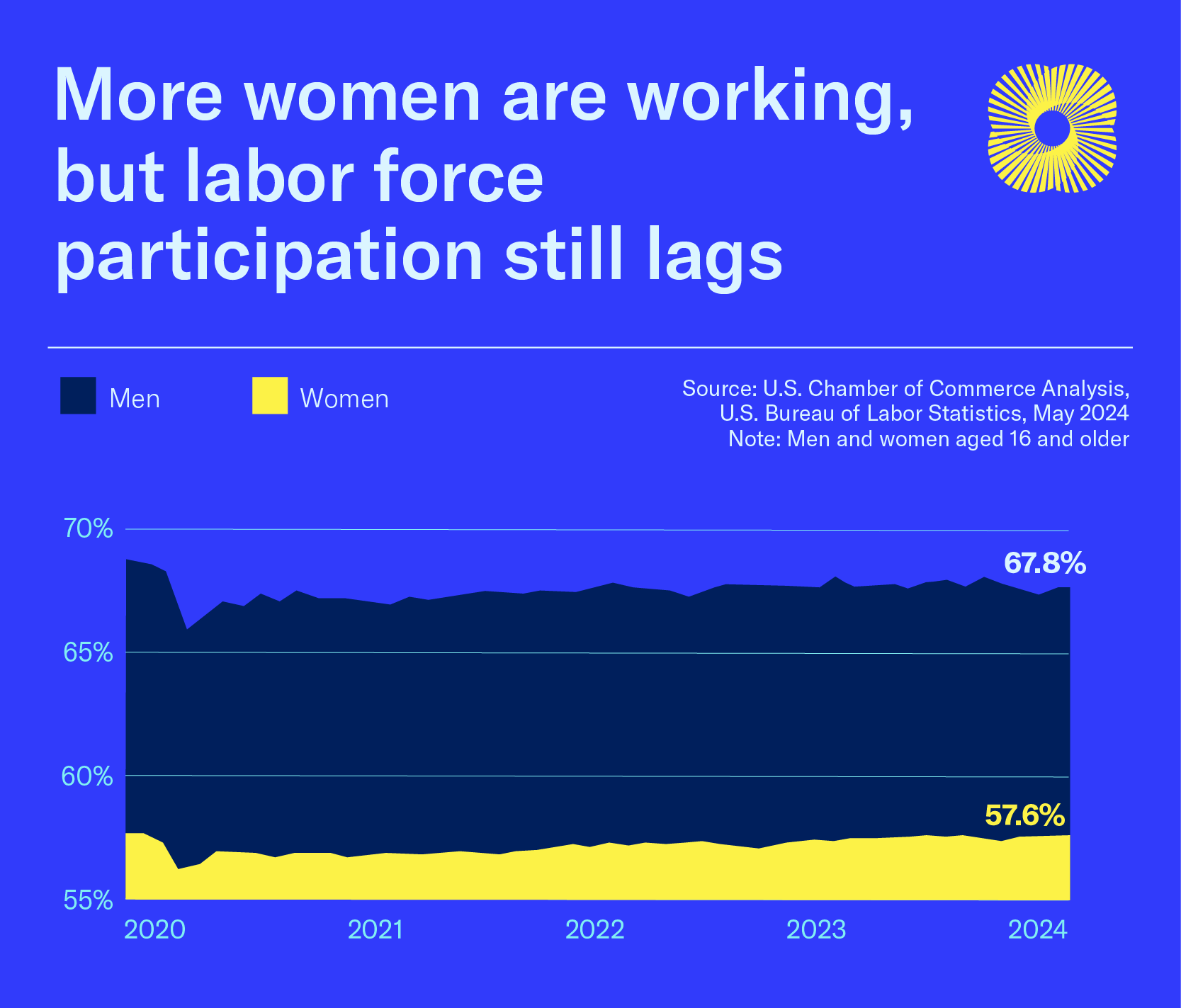 Stephanie Ferguson Melhorn
Stephanie Ferguson Melhorn
Senior Director, Workforce & International Labor Policy, U.S. Chamber of Commerce
Published
June 26, 2024
Companies of every size and industry and across every state are facing unprecedented challenges trying to find enough workers to fill open jobs. The latest data shows that there are 8.1 million job openings in the U.S. and 6.6 million unemployed workers.
One contributing factor to the shortage of workers is that the labor force participation rate has been gradually declining over the last twenty years. The COVID-19 pandemic further exacerbated the declining labor force participation rate, and neither men’s nor women’s participation has yet fully rebounded to pre-pandemic levels.

Women in the U.S. Workforce
Women entered the workforce in meaningful numbers in the 1920s, but it was mostly single women, as it was not customary for women to remain in the labor force after marriage. Participation amongst both single and married women climbed, however, for the next 50 years as education became more available, demand for workers increased, and the ability to postpone starting a family became more readily available.
Today, women represent 47% of all U.S. employees, and women are integral to our modern workforce. However, despite the strong presence of working women, inequities remain—and in some cases are expanding. These are worrying trends as the U.S. economy continues to face increased demand while also navigating a labor shortage.
The sheer number of women participating in the labor force today stands at 79 million, surpassing the pre-pandemic number by nearly 2 million. However, the overall share of women participating in the labor force lags compared to prior to the pandemic.
-
58.0%
Women's labor force participation rate in February 2020
-
57.6%
Women's labor force participation rate in May 2024

Just before the pandemic in February 2020, 59% of women over the age of twenty were participating in the labor force, compared to 71.4% of men. Both men and women suffered a 3% drop in labor force participation at the height of the pandemic. But more than two years later, men have returned to work at a higher rate than women.
The fact that labor force participation still lags for women has resulted in roughly 617,000 women missing from today’s labor force if the participation rate matched what it was in February 2020.
Looking at unemployment, historically, men have higher rates of unemployment compared to women. However, in April 2020, as the pandemic took hold, women’s unemployment surpassed men’s by 2.7%.

What's Causing Women Not to Work?
There are several factors contributing to a lower labor force participation rate for women. All are contributing to an ongoing workforce shortage that is unsustainable for the American economy.
More women stay home to care for children
While this number has been trending down, taking care of the home and family remains the leading reason mothers don’t participate in the labor force.
In 1989, 86% of mothers cited home and family care as the leading reason for exiting the workforce, while 79% reported the same reason in 2021. The share of fathers retracting from the labor force to care for the home and family has dramatically increased from just 4% in 1989 to 23% in 2021. Still, women overwhelmingly represent spouses who do not participate in the labor force to provide care – a necessary decision among the alarming cost of childcare.
A recent study shows that 74% of all mothers and 93.4% of all fathers with children under 18 years old were participating in the labor force in 2023. Both figures have risen compared to 2022, when 72.9% of mothers and 92.9% of fathers were working or looking for work. Mothers with children under six participate in the labor force at a rate of 68.9%, a rate significantly lower than that of other parents.
The prohibitive cost of childcare continues to be a leading obstacle to workers’ ability to stay in or reenter the workforce. Across the nation, the cost of care for just one child ranges between 8% and 19% of total family income. In New York and Massachusetts, childcare costs over one-fifth of household income. At this price, families often conclude it is better to have one parent remain home to provide that care – and the most common choice is the mother.

Women in the U.S. earn 16 cents per dollar less than men. Over the course of a week, women’s median wages trail men’s by $203, accumulating to a $10,000 deficit annually. This ‘salary gap’ can contribute to the decision for a working mother to stay home with their child rather than pay for childcare.
Views on work-life balance are shifting
While lower wages and insufficient childcare pose challenges to bringing women back into the workforce, these are not the only obstacles. In a 2021 survey, 45% of workers reported leaving the workforce because they lacked flexibility in the workplace. A USA Today survey found that U.S. workers strongly prefer working from home—so much, in fact, that 25% said they would resign if forced to return to the office.
In 2023, just a quarter of all employees worked remotely part of the time, signaling that some form of workplace flexibility is here to stay. The ability to work remotely or within flexible hours has supported families that are balancing childcare and work.
Despite increased flexibility that benefits both sexes, women continue to take the brunt of childcare responsibilities. This means short-term absences from work—like leaving early or taking sick days to care for kids—often affect women more and can be misconstrued as a decreased prioritization of work or the inability to manage the work-life balance. Long-term absences can also often cause women to miss promotion or growth opportunities, further widening the wage gap.
Women at Work
Since entering the workforce, women have been overrepresented in service jobs that provide care for others, like nurses, teachers, and secretaries. While more women are increasing representation across all sectors, they continue to be 10% more likely than men to serve in lower-paying jobs and are most likely to work in the education and healthcare industry.

At the occupational level, women also overwhelmingly work in care-providing occupations. The most popular occupations for women are most often tied to the medical field, children by way of education and childcare, or aesthetics.

While these trends have existed for decades, there are significant signs of change. Women just recently became the majority of the college-educated workforce, are now studying medicine at higher numbers than men, and have hit new records of Fortune 500 leadership. Despite these advancements, women continue to lag men on the corporate ladder.

A shortage of women in the workforce—and a shortage of workers overall—continues to cause long-term economic challenges for our nation, and the business community is taking notice. Businesses are implementing solutions to address obstacles that keep workers from joining the workforce, implementing flexible work arrangements, and investing in childcare solutions.
The U.S. Chamber of Commerce Foundation is calling for investments to be made in childcare, as well as helping employers navigate additional childcare support for working parents.
The U.S. Chamber and U.S. Chamber Foundation’s America Works initiative is mobilizing industry and government to swiftly address America’s deepening worker shortage crisis by providing research on underlying workforce issues, policy recommendations, and practical workforce solutions for businesses. Explore America Works.
For more information on national labor force participation, quit rates, and more, visit the America Works Data Center.
The U.S. Chamber and U.S. Chamber Foundation are helping employers discover and develop talent through the America Works Initiative. For more information, contact Stephanie Ferguson at sferguson@uschamber.com.
Find more workforce data
Explore the latest data on job openings, unemployment, labor force participation, quit rates, and more, paired with in-depth analysis of the trends.
About the authors

Stephanie Ferguson Melhorn
Stephanie Ferguson Melhorn is the Senior Director of Workforce & International Labor Policy. Her work on the labor shortage has been cited in the Wall Street Journal, Washington Post, and Associated Press.

Isabella Lucy
Isabella has created stunning visualizations tackling pressing issues like the worker shortage, the benefits of hiring veterans, the lifespan of small businesses, and the future of work.






